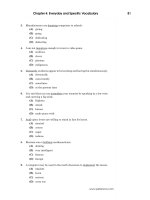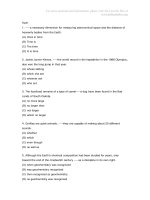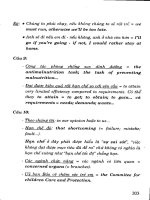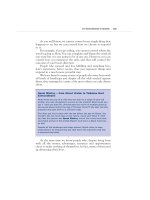master your mind master your destiny phần 10 pptx
Bạn đang xem bản rút gọn của tài liệu. Xem và tải ngay bản đầy đủ của tài liệu tại đây (742.99 KB, 39 trang )
MASTER YOUR MIND DESIGN YOUR DESTINY
312
Wealth & lifestyle Deadline Three action steps (36 hours)
1
2
3
4
Family & Friends Deadline Three action steps (36 hours)
1
2
3
4
Contribution Deadline Three action steps (36 hours)
1
2
3
4
313
DESIGN YOUR DESTINY
Take On a 36-hour Challenge
They say that taking the first step is the most difficult one. We
are often held back by inertia. The moment we start taking the
first few steps towards a goal, we will gain momentum and
continue on until we realize it. What has been an extremely
powerful strategy for the hundreds of participants that have gone
through the ‘Patterns of Excellence’ programs (and also for me),
is that for every goal we write down, we act on three action steps
within 36 hours of setting the goal.
No matter what goal it is, or how long term it is, there are
definitely three steps you can take within 36 hours that will
move you towards your goal.
It is a very powerful process… one of the most powerful steps
you take on this process involves putting yourself on the line by
making a commitment to other people. Or it involves
committing some money. By doing this, you are telling your
brain that you are serious about the time you are investing.
If your goal is to lose 5 kg in the next three months, what are
three steps you can take within 36 hours to commit yourself? You
could give away all your clothes and go out and replace it with a
wardrobe four sizes smaller.
You could sign up for an aerobics class and put down a
deposit. You could go and buy a book on ‘healthy eating’ and
read and follow it religiously.
There was a participant who set a goal of quitting and
starting his own business in two years time. Despite this being a
long-term goal, he sat down and wrote a business plan, registered
his business with $80 and signed up for a part-time course in
business management. All within 36 hours.
If your dream is to buy a Ferrari in five years time, you could
go down to the showroom right away to get a brochure and take
a test drive. So, write down your 36-hour action plan for each of
your major one-year goals.
Do it now!
MASTER YOUR MIND DESIGN YOUR DESTINY
314
Goals within Five Years
Personal Development Deadline
1
2
3
4
Career & Business Deadline
1
2
3
4
Wealth & Lifestyle Deadline
1
2
3
4
315
DESIGN YOUR DESTINY
Family & Friends Deadline
1
2
3
4
Contribution Deadline
1
2
3
4
Goals within Ten Years
Personal Development Deadline
1
2
3
4
MASTER YOUR MIND DESIGN YOUR DESTINY
316
Career & Business Deadline
1
2
3
4
Wealth & Lifestyle Deadline
1
2
3
4
Family & Friends Deadline
1
2
3
4
317
DESIGN YOUR DESTINY
Contribution Deadline
1
2
3
4
Goals within Fifteen Years
Personal Development Deadline
1
2
3
4
Career & Business Deadline
1
2
3
4
MASTER YOUR MIND DESIGN YOUR DESTINY
318
Wealth & Lifestyle Deadline
1
2
3
4
Family & Friends Deadline
1
2
3
4
Contribution Deadline
1
2
3
4
Now, take all your major one-year goals and put them through
the seven-step goal achievement process. You can do this in the
worksheets provided.
319
DESIGN YOUR DESTINY
Seven-Step Goal Achievement Process
1 What do you want specifically? What is the deadline?
2 Who can you model for excellence?
3 What specific actions/steps do you need to take to get there?
What are your deadlines? Schedule this in your organizer now!
4 What resources would you need? (people, money, talent, skills etc…)
5 What are 3 action steps to take within 36 hours?
6 Why must you achieve this goal?
7 Visualize this goal daily.
Seven-Step Goal Achievement Process Worksheet
1 What do you want specifically? What is the deadline?
2 Who can you model for excellence?
3 What specific action steps do you need to take to get there?
What are your deadlines? Schedule this in your organizer now!
MASTER YOUR MIND DESIGN YOUR DESTINY
320
4 What resources do you need? (people, money, talent, skills etc…)
5 What are 3 action steps to take within 36 hours?
6 Why must you achieve this goal?
7 Visualize this goal daily.
321
DESIGN YOUR DESTINY
The Power of Why
The next step is to list down all the reasons why you must achieve this goal. In
fact, I believe the ‘why’ is more important than the ‘how’. When you know why
you want something bad enough, you will eventually find out how to do it. So,
why is it important for you to achieve this goal? Again, all your reasons ‘why’
should be in line with your top values.
Visualization: Emotionally Charging Up Your Goals
This final step is an extremely powerful one. Remember again:
what drives our actions daily is not logic but the emotional states
we are in. Logically you may want to build your company to be
the next Fortune 500 but if you are not in a state of high
excitement, you will keep putting it off.
So you must keep getting yourself in a resourceful state by
emotionally charging up your goals. Do it daily! I personally love
to do this just before I sleep every night. What you do is to take
one major goal a night and to visualize yourself in the future
already achieving it. As you imagine the experience in your
mind, increase the intensity of the state by shifting your driver
submodalities.
MASTER YOUR MIND DESIGN YOUR DESTINY
322
Get associated into the experience and make the picture
bigger, closer and brighter. Make it into a movie and make the
sounds loud and in full stereo. Hear what you hear around you as
you are achieving this goal.
I can bet you that by doing this constantly with your major
goals, you will definitely find the energy and drive to take action
towards them.
I remember that the only way I managed to have the
discipline to write my first book was that every night I would
imagine myself in the bookstores signing autographs and seeing
the books flying off the shelves.
The image was so clear in my mind that it kept giving me the
energy to work on my book until it was finally complete. So start
visualizing your goals today!
Chapter Summary
1 Know what you want specifically. Only then can you develop a
specific strategy and focus your efforts towards your outcome.
2 Success rarely happens merely by chance.
Success happens by design.
3 What prevents most people from designing their destiny are:
●
Limiting beliefs
●
They don’t know what they really want
●
Fear of failure
●
Addiction to the soft life
●
Belief that goals do not work
4 Major keys in goal achievement
●
Specific & measurable
●
Passionate & exciting
●
Stretch goals create stretch ideas and results
5 You must design your life in these areas:
a Personal development
b Friends and family
c Wealth & lifestyle
d Career or business
e Contribution
6 Seven-Step Goal Achievement Process
a What do you want specifically? What is the deadline?
b Who can you model for excellence?
c What specific actions steps do you need to take to get
there? What are your deadlines? Schedule this in your
organizer now!
d What resources do you need? (people, money, talent,
skills etc…)
e What are 3 action steps to take within 36 hours?
f Why must you achieve this goal?
g Visualize this goal daily
ANYONE’S SUCCESS
BLUEPRINT
12
W
elcome to the final chapter! I am sure by now, you
would have experienced a major shift in your personal
effectiveness. In this chapter, we will further explore
the concept of modeling and how you can replicate the success
blueprints of models of excellence. One of the reasons I have
been able to achieve such exceptional results in such a short
period of time is that I have learnt how to become a master
modeler. I have identified fantastic role models in the area of
learning, speaking, wealth creation, selling and business and
have distilled their years of experience and accumulated
expertise into a series of strategies that I have adopted within a
few years.
Remember that we all have got basically the same neurology
(one thousand billion neurons) available to us. If someone is
more effective than you in a particular skill or behaviour, it is
because their neurology is running a more effective strategy.
They may have taken years of trial and error to build in their
ability to speak in a powerful manner, generate creative ideas or
MASTER YOUR MIND DESIGN YOUR DESTINY
326
stay relaxed in stressful situations. As a result, their brains have
formed an effective set of neural connections that generate the
desired states, behaviours and results. In this chapter you will
learn how to dissect a person’s success blueprint, replicate it and
install it within yourself.
When I modeled the top students and gifted children, I
discovered that the reason they were superior learners was
simply because they had a very effective strategy for generating
ideas, understanding new facts, memorizing it and solving
questions. 95% of the other students who were either average or
below average were not stupid, they just had an ineffective
strategy.
Let me give you an example of how changing your mental
strategy can significantly change the results you produce. Do you
have a good memory? Most people I ask would say ‘no’
immediately. Well, again if you forget things easily, it is not
because you do not have the ability to remember, you just have
an ineffective memory strategy. Take a look at the list below and
do your best to remember it in sequence. Give yourself a
maximum of one minute.
327
HOW TO REPLICATE ANYONE’S SUCCESS BLUEPRINT
1 Eggs 6 Fan 11 Michael Jackson 16 Numbers
2 Cow 7 Hair 12 Ear rings 17 Crown
3 Fork 8 Glucose 13 Frisbee 18 Fish balls
4 Bikini 9 Policeman 14 Planet 19 Clock
5 Banana 10 Zoo 15 Rainbow 20 Claws
Now, covering the list above (be honest!), do your best to
write down as many words as you can remember in the blank
spaces below.
1 6 11 16
2 7 12 17
381318
491419
510 1520
So how many words did you manage to recall in sequence?
Most people can only manage a maximum of seven to ten words.
Now, would you believe that it is possible to remember every single
word in sequence, within 2 minutes, given the right strategy?
Here is what I would like you to do. Using your imagination,
make a visual image of each word and associate it to the next
word in a humorous way. At the same time, say the word out
loud! Follow the associations I have created below…
Use your mind and visualize an egg. (say ‘egg’ out loud) Now, imagine
that the egg cracks and out pops a cow’s head. (say ‘cow’ out loud).
See that the cow has forks on its head (say ‘fork’). Imagine that the
fork is wearing a pink bikini. Suddenly, the bikini drops and bananas
are exposed. Imagine that the skin of the banana peels off and
becomes fan. The fan blows all your hair away. Your hairs flies and
gets glued to a ghost (sound like ‘glucose’). The glue ghost (glucose)
chases a policeman into the zoo. Inside the zoo, imagine seeing
Michael Jackson wearing ear rings. He then takes the ear rings and
throws it like a Frisbee. See the Frisbee spinning around the planet.
A rainbow appears. Then see that there are numbers dancing on the
rainbows. These numbers then join to make a crown. On the crown you
see fish balls which contain small clocks. On the hand of the clock
are claws.
MASTER YOUR MIND DESIGN YOUR DESTINY
328
Now, do your best to write down as many words as you can
remember in the blank spaces below.
1 6 11 16
2 7 12 17
381318
491419
510 1520
If you had followed the strategy, you would have no problem
remembering all 20 words in sequence. Why were you able to
remember so easily the second time? Well, simply because you
used the strategy people with exceptional memories use.
Most people try to remember by staring at the words and
repeating it to themselves over and over again. This visual external
& auditory digital (self talk) strategy is not effective at all.
Ineffective Memory Strategy
Visual external
➨
Auditory digital
seeing the words repeat words to yourself
329
HOW TO REPLICATE ANYONE’S SUCCESS BLUEPRINT
However, what I have found is that people with exceptional
memories tend to make an image of the word in their mind
(visual internal). They then associate the images together in an
emotionally outstanding way (kinesthetic). In addition, they say
the words out loud (auditory digital). Anyone who uses this
strategy will find themselves being able to remember lists and
list of words effortlessly. By adopting this memory strategy as
well as other powerful learning strategies in reading and
information processing, I managed to jump from a below average
student to among the top one percent of students in the country!
You can model and replicate the strategies of literally any
form of exceptional behaviour. In 2000, my partner Stuart Tan
was given a project by the Singapore Armed Forces Shooting
Contingent (SSC) to model its top shooters and transfer their
success blueprints to the new soldiers who were going to
compete in the upcoming ASEAN (Association of South East
Asian nations) Army Rifles Meet.
Modeling & Replicating the Strategies of Top Shooters
As narrated by Stuart Tan
The challenge is that Singapore is the only nation in South East Asia with
a large number of its top shooters being made up of national servicemen
who serve in the army for only two and a half years. Every year, they
find themselves having to compete in a shooting competition with career
soldiers in other countries who have ten to fifteen years of shooting
experience.
In the year 2001, many of the Army’s top shooters were going to leave the
force after serving their two and a half year term. The commanding officer
at the time wanted to find a way to retain their shooting skills and transfer
it to the new soldiers who were just going in. So I was given the top eight
shooters to model. It was an arduous task when I videotaped and analyzed
the physiological and mental strategies of these shooters. It wasn’t very
difficult to identify their strategies as they were distinctly different from
Effective Memory Strategy
Visual internal Kinesthetic internal Auditory digital
imagine images ➨ emotionally engaging ➨ say words aloud
& associate images i.e. humorous
MASTER YOUR MIND DESIGN YOUR DESTINY
330
novice shooters. The experts had a clear vision, a clear idea about their
outcomes, they conducted mental rehearsals for themselves, they learnt
beyond the point of remembering, they were technically well-versed, and
they executed their strategies in an optimum state. After I distilled the
blueprints of these top shooters, the Army then used it for their mental
training purposes while they continued with their usual physical routine.
Not surprisingly, in the following year, the Singapore Shooting contingent
came in champions in the ASEAN Army Rifles meet for the first time.
Modeling the Success Blueprint
So how do you go about modeling a person’s success blueprint?
In chapter 6, we talked about the power of modeling someone’s
PHYSIOLOGY (external behaviour). By modeling a person’s
physiology, we can quickly tap into their optimum states and
peak performance levels.
By observing and literally modeling the gestures, tonality,
facial expressions, posture and mannerisms of top speakers,
Stuart and I managed to become extremely powerful
communicators on stage within a short period of time. In his
work with the Army, a major portion of his modeling of the top
shooters was modeling their breathing patterns before and after
they squeezed the trigger. What made a key difference to their
accuracy were also their body position, eye movements and
focus.
If we want to replicate a person’s success, we must also model
their empowering
BELIEF SYSTEMS. Why? Remember that our
beliefs are like the operating system to our brain. They
determine how we filter and perceive what happens around us.
They determine how we respond and how we take action. By
observing and asking the role model questions, you can get a
sense of the beliefs they have. Here are some examples of the
empowering beliefs of effective communicators. It is these sets of
beliefs that truly set them apart from the average communicators.
331
HOW TO REPLICATE ANYONE’S SUCCESS BLUEPRINT
Beliefs of Highly Effective Communicators
●
Everyone has a different model of reality
●
The meaning of your communication is the response you get
●
Resistance is a sign of lack of rapport
●
There is no failure, only feedback
●
There are no resistant people, only inflexible communicators.
Beliefs of Successful Entrepreneurs
●
Everything is possible. It is only a question of strategy
●
Every failure lays the foundation for progress towards success
●
Everything happens for a beneficial reason
●
For things to change, I must change first
●
Behind every crisis lies an opportunity
The other thing we must model from someone who is
excellent in something is their
VALUES STRUCTURE. You have
learnt that the way we individually rank and define our values
(towards and away from) also determines the decisions we make
and what actions we take. Again, is it necessary to know the
person’s entire values structure? No! We just need to get a sense
of what drives them towards what they do. We can simply do
this by asking, ‘What’s important to you about what you do?’
(refer to Chapter 10). For example, when I was modeling the
values of a top insurance advisor (who earned over $600,000pa),
I found that her towards values were ‘contribution’, ‘passion’,
‘money’ and ‘accomplishment (of a great challenge)’. At the
same time, her away-from values were ‘losing’ (she hated to lose
to anyone), ‘giving up’ (she always persisted until she got what
she wanted) and boredom (she could not keep still). These
values sets drove her to become top advisor of the year for six
years in a company of over 3000 professionals.
The final thing we must model in a person’s success blueprint
is their
MENTAL PROCESSING STRATEGIES. Commonly
known as
STRATEGIES. Every behavior (positive or negative)
we perform begins with a specific mental strategy that we run in
our brain. In order to generate brilliant ideas, a person runs a
specific ‘creative’ mental strategy in their neurology. Similarly,
in order for us to feel ‘love’ or ‘depressed’, our neurology must
run certain mental strategies that produce these states and
behaviors.
MASTER YOUR MIND DESIGN YOUR DESTINY
332
Strategies: Our Mental Roadmap
So what is a mental strategy? It is a specific sequence of internal
and external experiences we run in our brain in order to produce
a specific outcome. It is what a person does in his brain that
produces a specific result. For example, how do you wake up in
the morning? In order to perform the behavior of ‘waking up’,
your brain goes through a mental strategy. And all of us have
different mental strategies for waking up in the morning. For
some people, when they hear the alarm go off, they would look
at the clock and say to themselves, ‘What time is it? How much
longer can I sleep?’ They then shut it off, feel the warmth of
their blanket, say to themselves ‘just five more minutes’ and doze
off again. A few minutes later, they would start making pictures
in their head of how they will get into trouble for being late.
This triggers off a feeling of panic and an internal voice that
goes, ‘Oh Shit! I’m late!’ they will then jump out of bed twenty
minutes late. This is obviously an ineffective waking up strategy
that probably gets you always to be late.
Again, are there some people who are able to get themselves
up bright and early? Yes! How do they do it? Well, they just have
a more effective mental program running. By modeling these
people’s waking up strategy and installing it in my neurology
(you will learn how to do this), I find myself getting up on time
easily.
So, think about it. What is your strategy for waking up in the
morning? What is the first thing that happens in your mind as
HEAR ➨
ALARM
Make a picture ➨
of all the great
things you can
achieve today
Say to yourself,
➨
‘Time to get up!’
Feel ➨
excited
Jump out
➨
of bed
Switch
off the alarm
HEAR ALARM
Say, ‘how
➨
much longer
can I sleep?
Shut off
➨
alarm
Feel
➨
warmth
of blanket
Say ‘just
➨
five more
minutes’
Make
➨
pictures of
being late
Say,
➨
‘Oh shit’
Feel
➨
panic
Jump out
of bed late
Look
➨
at time
Ineffective Waking Up Strategy
Effective Waking Up Strategy
333
HOW TO REPLICATE ANYONE’S SUCCESS BLUEPRINT
the alarm clock rings? Do you make a picture in your mind? Say
something to yourself? Switch off the alarm immediately? How
do you eventually get out of bed? Take about 5 minutes and use
the space below to map out your strategy.
We use mental processing strategies for everything we do.
All our states and external behaviours are controlled by these
internal processing strategies. We have strategies for falling in
love, buying, motivation, learning, decision-making, writing,
communication, procrastination and creativity. There are
strategies for everything. It is just that many of us have never
been aware of our mental strategies.
We must start becoming aware of our own mental strategies,
both the useful ones and the non-useful ones. If you have a
useful strategy for creativity, you must discover how you do it. In
this way, you can replicate your creativity at any time and in any
given situation. If you have a lousy ‘waking up strategy’ or ‘anger
strategy’, you must discover how it runs so you can begin to
change it!
What Makes Up a Strategy?
So, what makes up a strategy? Well, if you think about it, there
are only three major things we can run in our brain. We can
either make Pictures (Visual), Sounds (Auditory) or Feelings
(Kinesthetic). These Pictures, Sounds and Feelings can be either
External or Internally generated. For example, a Visual External
(Ve) experience is when we see the alarm clock. A Visual
Internal (Vi) experience is when we make a picture in our minds
i.e. imagining ourselves arriving late.
MASTER YOUR MIND DESIGN YOUR DESTINY
334
An Auditory External (Ae) experience is when we hear the
alarm clock ringing. An Auditory Internal (Ai) is when we play
sounds in our mind. An Auditory Digital (Ad) experience is
when we are talking to ourselves or trying to make sense out of
something. i.e. saying to ourselves, ‘Just five more minutes.’
A Kinesthetic External (Ke) experience is when we
physically touch something, like feeling the warmth of the
blanket. It also includes an external smell or taste. A Kinesthetic
Internal (Ki) experience is when we feel emotions like ‘panic’ or
when we imagine in our minds what it would be like to touch a
snake. Again, it could also include imagining what something
would taste or smell like.
VISUAL V
External Ve Seeing something
Internal Vi Making a picture in our heads
Do note that in order to be even more specific, when we visualize
something in our minds (Vi), we can either imagine an image we have seen
before (known as visual remembered or Vr) or we can make up something
new (known as visual constructed Vc).
Vi
AUDITORY A
External Ae Hearing a sound
Internal Ai Making sounds in our head (the tone)
Digital Ad Self talk & reasoning
When dealing with auditory, you want to be clear about the difference
between auditory internal (Ai) and auditory digital (Ad). Auditory internal (Ai)
is more concerned about the tone of the sounds, whether it ‘sounds right’.
Auditory digital (Ad) is more concerned with the content of the words,
whether it ‘makes sense’.
KINESTHETIC K
External Ke Physical movement (motor) or
feeling a sensation (tactile)
Internal Ki Emotion or imagining a feeling
Vr (visual remembered)
e.g. Recalling what your room looks like.
Vc (visual construct)
e.g. Imagining what it would be like to achieve
a future goal
➤
➤
335
HOW TO REPLICATE ANYONE’S SUCCESS BLUEPRINT
Notice, that we use a lot of notations in describing strategies.
These notations make it a lot easier and efficient to study our
mental strategies.
What makes up a strategy is not just what we run in our
brains, but the order and sequence in which we run it. Just by
changing the sequence of what we run, the entire outcome of
the strategy changes. For example, let’s look back at the effective
‘waking up strategy’.
Effective Waking up Strategy
In the last part of this strategy, you should ‘jump out of bed’ (Ke)
and then ‘switch of the alarm’ (Ke). If we were to change the
sequence to ‘switch off the alarm’
➨ ‘Jump out of bed’, would it
work as well? Maybe not. Why? By switching off the alarm
before getting out of bed, it may cause you to lie on the bed and
feel lethargic again (Ki).
A good metaphor for understanding the concept of strategies
is in the baking of a cake. Imagine if there was a famous chef
who could bake a delicious cake. He may have taken years of
trial and error to produce a cake of such high quality. However,
within a matter of minutes, you too could bake the same quality
of cake. How? All you would need would be his recipe and to
follow it precisely. You will have to use the same ingredients, the
exact amounts and well as the sequence in which they are
added.
Similarly, in the modeling of human behaviour and results,
we need to find out the recipe for excellence. The ingredients in
this case would be the visual, auditory or kinesthetic elements.
The amounts would be the submodalities of our experience. For
example, is the visual image large or small, associated or
disassociated? Finally, the sequence of these experiences must be
replicated precisely.
Ae ➨ Vc ➨ Ad ➨ Ki ➨ Ke ➨ Ke
Imagine all the
things you can
achieve today
Say to yourself,
‘Time to get up!’
Feel
excited
HEAR
ALARM
Jump out
of bed
Switch
off the alarm
MASTER YOUR MIND DESIGN YOUR DESTINY
336
Do know that in understanding a person’s strategy, we are
not so much interested in the content of the thought, but the
form. You might say, ‘I thought of this’ or ‘I thought about that’
or ‘I thought of a car’. Rather than the content (what you
actually thought of), we are more interested in the structure and
sequence of the thought. In other words, did you make a picture
in your mind? Did you say something to yourself? Did you have
an internal emotion? And, what was the sequence of it? Did you
make a picture in your head and hear a sound or was it the other
way around?
Why Learn Strategies
Besides being able to model and replicate strategies from an
individual who is excellent at producing a particular result, there
are many more reasons for discovering our own strategies and
that of other people.
A very important reason for discovering our own strategies is
to be able to replicate our own excellent states and past
performances at will. Haven’t you ever experienced a time when
you were especially creative in generating ideas, whereas in
another point of time you felt a creative block? When we can
discover what our strategy for motivation, creativity or love is,
we can trigger these states and behaviors whenever we need to!
For example, I discovered that I am able to write (my books)
most effectively when I imagine myself in front of an audience
(Vi) and hear myself giving a talk (Ad). While I see and hear
this in my mind, I type out the words of my talk (Ke). When I
use this particular sequence of internal experiences, my mind
gets into its most creative mode and the words just flow out. By
the way, this is the reason why my writing style is so
conversational in nature.
When we discover someone else’s strategy, we can also utilize
it to help them achieve their peak states and outcomes. For
example, let’s say that you discovered that your son’s motivation
strategy was Ve
➨ Ad ➨ Ki. In other words, in order to access
the state of motivation, he has to see something, then say
something to himself and this gets him to feel motivated. You
can talk to this person (Ae) about why they should be motivated









